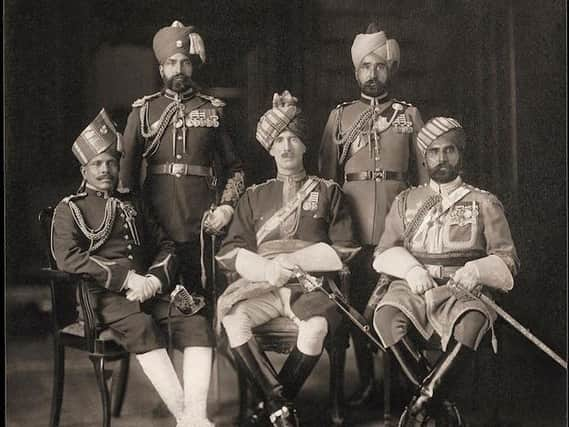Nostalgia: How former soldiers helped to fill the nation's labour shortage


The royal tour was to have a symbolic impact on our Heavy Woollen District.
The visit cleared the way for large numbers of Indian and Pakistani migrant workers to come and work in the empty mills of Dewsbury, Batley, Heckmondwike and Huddersfield at a time when there was a severe labour shortage across the whole country.
Advertisement
Hide AdAdvertisement
Hide AdBut the origins behind the arrival of such a large workforce can be traced back even before the Queen’s visit in 1961 (as we shall see in this week’s article).
This week’s fifth Reporter series feature on Asian nostalgia looks at what life was like for the British-Indian soldiers after the Second World War.
The article also touches on the first post-war migration of Indian and Pakistani workers from the Sub-Continent to our Heavy Woollen District.
Nearly two million soldiers from the British-Indian Army had been on active duty in South-East Asia and in Europe during the war years of 1939 to 1945.
Advertisement
Hide AdAdvertisement
Hide AdYet most of the soldiers were sent back home to India a few months after the Second World War ended - only to see their own country in turmoil. The British government in London was getting ready to give independence to the Sub-Continent after 90 years of Imperial rule.
The situation, however, was very complex. Indian leaders like Gandhi had made the mistake of bringing religion into politics. Gandhi’s policy led to communal riots breaking out between Hindus, Muslims, and Sikhs.
As a result, some political groups in India wanted the country to be partitioned by the British government. The idea was to create a new homeland known as Pakistan.
Partition did eventually happen. India was given independence in August 1947 - and the new Muslim nation state of Pakistan was also created at the same time.
Advertisement
Hide AdAdvertisement
Hide AdBut the British-Indian Army ended up getting disbanded. The British were ready to leave India - so the name “British” in the Indian Army also had to go.
Partition was to have a direct impact on the lives of these once proud British-Indian soldiers. As men who had fought so bravely in the war, they were now demobilised and out of a job.
The vast majority ended up going back home to their villages in Punjab, Kashmir and to the North West Frontier Province. All they now had were some fond memories of the old army life.
In fact, military service in the British-Indian Army had become an important part of their culture and heritage.
Advertisement
Hide AdAdvertisement
Hide AdOne of the most common sights even after the war was to see a big moustache on the faces of many former “Sephoys”. A neatly trimmed beautiful dark moustache was the proud trademark sign of an ex-British-Indian Army soldier.
Besides the moustache, the men had always felt a huge sense of pride having worn an army uniform. It was an immense prestige to have been a “Sephoy” in the British-Indian Army - and group photographs such as the one of King’s Bengal Orderly Officers - published in this week’s feature - were cherished family possessions.
The governing elite in London meanwhile remembered the British-Indian Army’s contribution during the war. Thousands of brave Indian “Sephoys” had made the ultimate sacrifice by fighting and dying for what they saw as a worthy cause.
One of these brave men was Hawaldar (“Sergeant”) Abdul Hafiz from the 9th Jat Regiment. He had led an assault against a heavily armed Japanese machine-gun post in Burma.
Advertisement
Hide AdAdvertisement
Hide AdDespite intense gun fire, the brave “Sephoy” was able to overun the enemy post. He died in combat and was posthumously awarded the Victoria Cross for his utmost bravery.
Many others like Sergeant Abdul Hafiz had shown their dedication, as well as their discipline, and had also given their lives for Britain.
But the good news was lots more of these former soldiers were still alive and well! They now needed work and something to do.
The London establishment, on the direction of Prime Minister Clement Attlee’s newly elected Labour government, was, after 1945, eager to get Britain’s factories moving back to peacetime work.
Advertisement
Hide AdAdvertisement
Hide AdBut there was a dilemma. The country was facing a shortage of skilled workers.
This problem was to last into the next two decades of the 1950s and Sixties - until large numbers of Afro-Caribbean, as well as Indian and Pakistani migrant workers, came over to fill in the severe labour shortages.
Our own Heavy Woollen District saw the arrival of a first small wave of migrant workers. There were already small pockets of what local white English-speaking residents used to describe as “Asian” homes by the late 1950s in areas like Mount Pleasant in Batley, in Savile Town as well as in parts of Ravensthorpe in Dewsbury, and in the town of Heckmondwike.
Some of Sergeant Abdul Hafiz’s relatives also came over during this period to settle in Huddersfield and Dewsbury.
They had left the days of the army drill behind. The time had now come to move onto the factory shift.